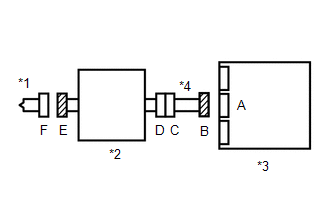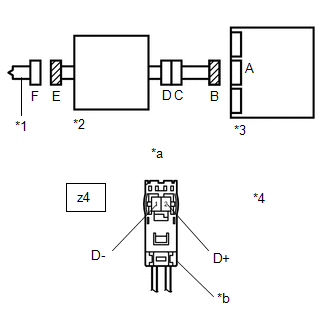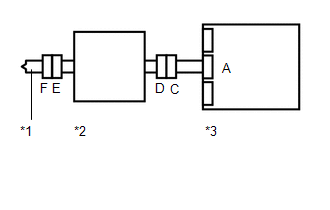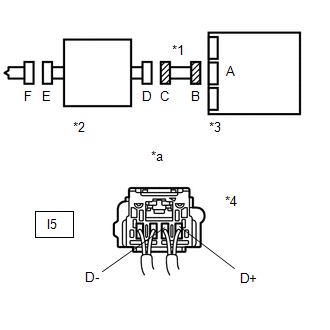Lexus NX: Short in D Squib Circuit (B1800-B1803)
DESCRIPTION
The driver side squib circuit consists of the airbag ECU assembly, spiral cable sub-assembly and horn button assembly.
The circuit instructs the SRS to deploy when deployment conditions are met.
These DTCs are stored when a malfunction is detected in the driver side squib circuit.
| DTC No. | Detection Item | DTC Detection Condition | Trouble Area |
|---|---|---|---|
| B1800 | Short in D Squib Circuit | One of the following conditions is met:
|
|
| B1801 | Open in D Squib Circuit | One of the following conditions is met:
|
|
| B1802 | Short in D Squib Circuit (to Ground) | One of the following conditions is met:
|
|
| B1803 | Short in D Squib Circuit (to +B) | One of the following conditions is met:
|
|
WIRING DIAGRAM
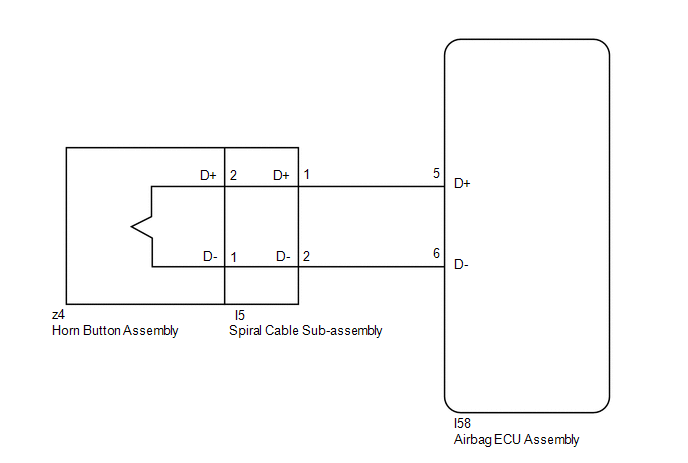
CAUTION / NOTICE / HINT
NOTICE:
-
When installing the spiral cable sub-assembly and steering wheel, be sure to adjust the spiral cable sub-assembly as it may break if the steering wheel is turned before adjusting the spiral cable sub-assembly.
Click here
.gif)
-
After the power switch is turned off, there may be a waiting time before disconnecting the negative (-) auxiliary battery terminal.
Click here
.gif)
-
When disconnecting and reconnecting the auxiliary battery
Click here
.gif)
HINT:
When disconnecting and reconnecting the auxiliary battery, there is an automatic learning function that completes learning when the respective system is used.
Click here
.gif)
-
After replacing the airbag ECU assembly, refer to initialization.
Click here
.gif)
.gif)
.gif)
HINT:
To perform the simulation method, enter check mode (signal check) with the Techstream (Click here .gif) ), and then wiggle each connector of the airbag system or drive the vehicle on various types of road (Click here
), and then wiggle each connector of the airbag system or drive the vehicle on various types of road (Click here .gif) ).
).
PROCEDURE
| 1. | CHECK HORN BUTTON ASSEMBLY |
| (a) Turn the power switch off. |
|
(b) Disconnect the cable from the negative (-) auxiliary battery terminal, and wait for at least 90 seconds.
(c) Disconnect the connector from the horn button assembly.
(d) Connect the white wire side of SST (resistance: 2.1 Ω) to connector E (orange connector).
CAUTION:
Never connect the tester to the horn button assembly for measurement, as this may lead to a serious injury due to airbag deployment.
NOTICE:
- Do not forcibly insert SST into the terminals of the connector when connecting SST.
- Insert SST straight into the terminals of the connector.
SST: 09843-18061
(e) Connect the cable to the negative (-) auxiliary battery terminal, and wait for at least 2 seconds.
(f) Turn the power switch on (IG), and wait for at least 60 seconds.
(g) Clear the DTCs.
Click here .gif)
(h) Turn the power switch off.
(i) Turn the power switch on (IG), and wait for at least 60 seconds.
(j) Check for DTCs.
Click here .gif)
HINT:
Codes other than DTC B1800, B1801, B1802 and B1803 may be output at this time, but they are not related to this check.
(k) Turn the power switch off.
(l) Disconnect the cable from the negative (-) auxiliary battery terminal, and wait for at least 90 seconds.
(m) Disconnect SST from connector E.
| DTC B1800, B1801, B1802 or B1803 is not output | .gif) | REPLACE HORN BUTTON ASSEMBLY |
|
| 2. | CHECK CONNECTORS |
(a) Disconnect the connectors from the airbag ECU assembly.
| (b) Check that the connectors (on the airbag ECU assembly side and horn button assembly side) are not damaged. OK: The lock button is not disengaged, and the claw of the lock is not deformed or damaged. |
|
| NG | .gif) | REPLACE INSTRUMENT PANEL WIRE OR SPIRAL CABLE SUB-ASSEMBLY |
|
| 3. | CHECK DRIVER SIDE SQUIB CIRCUIT |
| (a) Connect the cable to the negative (-) auxiliary battery terminal, and wait for at least 2 seconds. |
|
(b) Turn the power switch on (IG).
(c) Measure the voltage according to the value(s) in the table below.
Standard Voltage:
| Tester Connection | Switch Condition | Specified Condition |
|---|---|---|
| z4-2 (D+) - Body ground | Power switch on (IG) | Below 1 V |
| z4-1 (D-) - Body ground | Power switch on (IG) | Below 1 V |
(d) Turn the power switch off.
(e) Disconnect the cable from the negative (-) auxiliary battery terminal, and wait for at least 90 seconds.
(f) Measure the resistance according to the value(s) in the table below.
Standard Resistance:
| Tester Connection | Condition | Specified Condition |
|---|---|---|
| z4-2 (D+) - z4-1 (D-) | Always | Below 1 Ω |
(g) Release the activation prevention mechanism built into connector B.
Click here .gif)
(h) Measure the resistance according to the value(s) in the table below.
Standard Resistance:
| Tester Connection | Condition | Specified Condition |
|---|---|---|
| z4-2 (D+) - z4-1 (D-) | Always | 1 MΩ or higher |
(i) Restore the released activation prevention mechanism of connector B to its original condition.
(j) Measure the resistance according to the value(s) in the table below.
Standard Resistance:
| Tester Connection | Condition | Specified Condition |
|---|---|---|
| z4-2 (D+) - Body ground | Always | 1 MΩ or higher |
| z4-1 (D-) - Body ground | Always | 1 MΩ or higher |
| NG | .gif) | GO TO STEP 5 |
|
| 4. | CHECK DTC |
| (a) Connect the connectors to the horn button assembly and airbag ECU assembly. |
|
(b) Connect the cable to the negative (-) auxiliary battery terminal, and wait for at least 2 seconds.
(c) Turn the power switch on (IG), and wait for at least 60 seconds.
(d) Clear the DTCs.
Click here .gif)
(e) Turn the power switch off.
(f) Turn the power switch on (IG), and wait for at least 60 seconds.
(g) Check for DTCs.
Click here .gif)
HINT:
Codes other than DTC B1800, B1801, B1802 and B1803 may be output at this time, but they are not related to this check.
| DTC B1800, B1801, B1802 or B1803 is not output | .gif) | USE SIMULATION METHOD TO CHECK |
| DTC B1800, B1801, B1802 or B1803 is output | .gif) | REPLACE AIRBAG ECU ASSEMBLY |
| 5. | CHECK INSTRUMENT PANEL WIRE |
| (a) Disconnect the instrument panel wire connector from the spiral cable sub-assembly. |
|
(b) Connect the cable to the negative (-) auxiliary battery terminal, and wait for at least 2 seconds.
(c) Turn the power switch on (IG).
(d) Measure the voltage according to the value(s) in the table below.
Standard Voltage:
| Tester Connection | Switch Condition | Specified Condition |
|---|---|---|
| I5-1 (D+) - Body ground | Power switch on (IG) | Below 1 V |
| I5-2 (D-) - Body ground | Power switch on (IG) | Below 1 V |
(e) Turn the power switch off.
(f) Disconnect the cable from the negative (-) auxiliary battery terminal, and wait for at least 90 seconds.
(g) Measure the resistance according to the value(s) in the table below.
Standard Resistance:
| Tester Connection | Condition | Specified Condition |
|---|---|---|
| I5-1 (D+) - I5-2 (D-) | Always | Below 1 Ω |
(h) Release the activation prevention mechanism built into connector B.
Click here .gif)
(i) Measure the resistance according to the value(s) in the table below.
Standard Resistance:
| Tester Connection | Condition | Specified Condition |
|---|---|---|
| I5-1 (D+) - I5-2 (D-) | Always | 1 MΩ or higher |
(j) Restore the released activation prevention mechanism of connector B to its original condition.
(k) Measure the resistance according to the value(s) in the table below.
Standard Resistance:
| Tester Connection | Condition | Specified Condition |
|---|---|---|
| I5-1 (D+) - Body ground | Always | 1 MΩ or higher |
| I5-2 (D-) - Body ground | Always | 1 MΩ or higher |
| OK | .gif) | REPLACE SPIRAL CABLE SUB-ASSEMBLY |
| NG | .gif) | REPLACE INSTRUMENT PANEL WIRE |

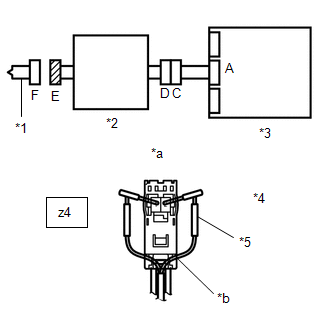
.gif)
